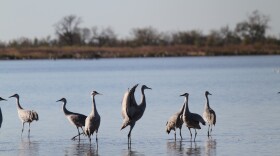Oklahoma may experience above-average warm and dry conditions for the rest of the winter season with the long-awaited arrival of La Niña. The phase is one part of the El Niño/Southern Oscillation, which alters weather patterns globally and is driven by sea surface temperatures.
Although La Niña is known for its cooling effect, the event impacts regions differently. Conditions for drought in Oklahoma’s winter and spring months become more likely under its influence.
“ La Niña, generally, is a fairly serious climatic pattern for us here in the Southern Great Plains because it does result in even drier than normal winters and springs,” said Todd Lindley, science and operations officer for the National Weather Service in Norman. “So, it's something we're always keeping an eye on.”
Still, this year’s La Niña will likely have less of a sway over weather patterns because of its delayed development, according to the National Oceanic and Atmospheric Administration. The federal scientists suggest the globe’s unusually warm oceans may have slowed its formation.
Sea surface temperatures have risen significantly over the past 30 years, largely driven by fossil fuel emissions trapping heat in the atmosphere.
La Niña could last through the spring, though researchers can’t predict its exact duration. The last one stretched over three years from 2020 to 2023.









